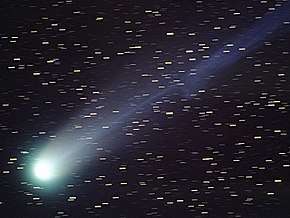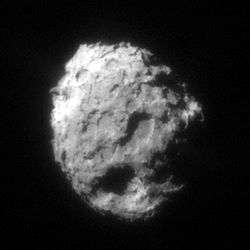12P/Pons–Brooks
12P/Pons–Brooks is a periodic comet with an orbital period of 71 years. It fits the classical definition of a Halley-type comet with (20 years < period < 200 years).[1] The next perihelion passage is 20–21 April 2024,[4][lower-alpha 1] with closest approach to Earth being 1.54 AU (230 million km) on 2 June 2024.
| Discovery | |
|---|---|
| Discovered by | Jean-Louis Pons William Robert Brooks |
| Discovery date | July 12, 1812 |
| Alternative designations | 1812; 1884 I; 1954 VII;[1] C/1457 A1; C/1385 U1[2] |
| Orbital characteristics A | |
| Epoch | 1954-Sep-15[1] |
| Aphelion | 33.468 AU |
| Perihelion | 0.77366 AU |
| Semi-major axis | 17.121 AU |
| Eccentricity | 0.95481 |
| Orbital period | 70.85 yr |
| Inclination | 74.176° |
| Earth MOID | 0.187 AU (28.0 million km) |
| Last perihelion | May 22, 1954[3] January 25, 1884 September 15, 1812 |
| Next perihelion | April 20–21, 2024[4][lower-alpha 1] |
12P/Pons–Brooks may be the parent body of the December κ-Draconids meteor shower.[5]
Comet Pons-Brooks was discovered at Marseilles Observatory in July 1812, and then later recovered in 1883.[6]
On 10 June 2020 Pons–Brooks was recovered at apparent magnitude 23 by the Lowell Discovery Telescope when the comet was beyond the orbit of Saturn at 11.9 AU (1.78 billion km) from the Sun.[7][8] The uncertainty in the comet's heliocentric distance is roughly ±10000 km.[9]
Discovery
Comet 12P/Pons–Brooks was discovered on July 12, 1812, by Jean-Louis Pons. Independently, this comet was later found by Vincent Wisniewski on August 1, and Alexis Bouvard on August 2 the same year. At the time no-one had brought these observations together.
In 1883 a (faint) comet was accidentally discovered by William Robert Brooks and later identified with the comet of 1812. Shortly after its initial discovery it was found to have an orbital period of about 70 years with an error of about 5 years. Johann Franz Encke determined a definitive orbit with a period of 70.68 years. This orbit was used to generate an ephemeris for the 1883-4 return, but searches were unsuccessful, until it was rediscovered by Brooks. This year it traveled from Scheat and Markab in western Pegasus, 13 January 1884; southward (through Pisces) to reach perihelion below Iota and Beta Ceti (~RA 0h, Dec. -10°) around 24 January.[10]
Orbit
| Date | Distance (AU) | Solar elongation |
|---|---|---|
| 1884-Jan-09 | 0.63 AU (94 million km) | 58° |
| 1954-Jun-29 | 1.6 AU (240 million km) | 38° |
| 2024-Jun-02 | 1.5 AU (220 million km) | 45° |
| 2095-Aug-27 | 1.5 AU (220 million km) | 31° |
Libration is locked at a 6:1 resonance with Jupiter.[11] The Tisserand invariant with respect to Jupiter (J) is 0.60.[12] Aphelion (furthest point from the Sun) is just beyond the orbit of Neptune at 33 AU (4.9 billion km).
With a steep orbital inclination of 74.2° this comet does not spend a lot of time near the ecliptic. The Jet Propulsion Laboratory's (JPL) website shows that between the years 1900 and 2200, that the comet was and will be most significantly perturbed by Saturn on July 29, 1957. At that point it passed within 1.6AU of the giant planet's influence; even this approach had negligible effect.[13] The comet's orbit appears to be stable between 1740 and 2167, with no strong perturbations by any of the planets.[14][15]
Kirkwood in 1884 noticed that Pons-Brooks shares elements with De Vico's comet of 1846. He suggested that the latter had calved off Pons-Brooks some centuries prior.[16] Later he identified the two comets' capture into their elliptical orbits (or their parent body's capture) with their shared aphelion close to Neptune 991 CE.[17]
Speculations
Bonilla's comet
On August 12-13th of 1883, Mexican astronomer José Bonilla observed 447 bodies cross the solar disc, from an observatory in Zacatecas. Mexican astronomers in 2011 suggested that a comet may have split into several pieces. These objects were estimated to have had a size of between 46 and 1022 meters, and to have passed only 538 to 8062 km from the Earth. They raised Pons-Brooks as one possibility, in which case Earth barely avoided multiple Tunguska events or even a mass extinction.[18] This was reported in the media October 2011.[19][20]
But the source of these objects could also have been comet C/1883 D1 (Brooks-Swift) or even a third, unknown comet that year. The event also coincided with the annual Perseids meteor shower. Even migrating birds cannot be ruled out.[18]
Ancient times
Chinese historiography records, although long after the fact, its first comet around 1500 BCE. This "broom-star" is said to have heralded the sweeping-away of the as tyrannical described Xia dynasty (and its replacement with the Shang dynasty).[21]
1954
Pons–Brooks came to perihelion on May 22, 1954[3] when it was 1.7 AU from Earth. On 10 December 1954, the meteor stream of comet Pons–Brooks passed about 0.12 AU (18 million km) from Earth, resulting in potential meteors impacting Earth`s atmosphere at relative velocity 45 km/s.[22] The comet was recovered in June 2020, and perihelion passage is in April 2024.[8]
Other comets with a similar orbital period include 13P/Olbers, 23P/Brorsen-Metcalf, 122P/de Vico and 1P/Halley.
Notes
- Ephemeris generated by JPL 16 (Soln.date: 2020-Jun-29 10:49:26) has 12P/Pons-Brooks coming to perihelion at 2024-Apr-21 00:10.
References
- "12P/Pons-Brooks". JPL Small-Body Database. Jet Propulsion Laboratory. SPK-ID: 1000068. Retrieved 2011-10-17.
- Comet 12P/Pons-Brooks-Identical to comets C/1457 A1 and C/1385 U1 (Maik Meyer)
- 12P/Pons-Brooks – Seiichi Yoshida @ aerith.net
- "12P/Pons-Brooks Orbit". Minor Planet Center. Retrieved 2020-06-28.
- Tomko, D.; Neslusan, L. (2016). "Meteoroid stream of 12P/Pons-Brooks, December κ-Draconids, and Northern June Aquilids". Astronomy & Astrophysics. 592. doi:10.1051/0004-6361/201628404.
- Yeomans, D. K. (April 1986). "The intermediate comets and nongravitational effects". Astronomical Journal. 91 (4): 971-973. Bibcode:1986AJ.....91..971Y. doi:10.1086/114073. ISSN 0004-6256.
- "MPEC 2020-M114 : OBSERVATIONS AND ORBITS OF COMETS AND A/ OBJECTS". IAU Minor Planet Center. 2020-06-26. Retrieved 2020-06-28.
- Quanzhi, Ye; Farnham, Tony L.; Knight, Matthew M.; Holt, Carrie E.; Feaga, Lori M. (2020). "Recovery of Returning Halley-Type Comet 12P/Pons-Brooks With the Lowell Discovery Telescope". American Astronomical Society. arXiv:2007.01368.
- Horizons output. "Observer Table for Comet 12P/Pons-Brooks" (Soln.date: 2020-Jun-29). Retrieved 2020-08-08. (Observer Location:@sun and Table Settings: 39. Range)
- William Dawson (1884). "The Pons-Brooks Comet". The Friend. 57: 194.
- Carusi et al. (1987), p. 900.
- Carusi et al. (1987), p. 899.
- "12P/Pons-Brooks close-approach data". JPL Small-Body Database. Jet Propulsion Laboratory. SPK-ID: 1000068. Retrieved 2009-05-06.
- Kronk, Gary W. (2001–2005). "12P/Pons-Brooks". Archived from the original on 2008-07-05. Retrieved 2009-05-07. (Cometography Home Page)
- Carusi et al. (1987), p. 905.
- Kirkwood, Daniel (February 1884). "The Comet of 1812 and 1883". Popular Science Monthly. Vol. 24. pp. 488–491.
- Kirkwood, Daniel (January 1886). "The Comets 1812 I, and 1846 IV". The Sidereal Messenger. 5: 13–14. Bibcode:1886SidM....5...13K.
- Manterola, Hector Javier Durand; de la Paz Ramos Lara, Maria; Cordero, Guadalupe (2011). "Interpretation of the observations made in 1883 in Zacatecas (Mexico): A fragmented Comet that nearly hits the Earth". arXiv:1110.2798.
- "Billion-Ton Comet May Have Missed Earth by a Few Hundred Kilometers in 1883". MIT Technology Review. 17 October 2011.
- "Did a massive comet almost wipe out humans in 1883?". The Week. October 18, 2011.
- Carl Sagan (1985). Comet. Michael Joseph. pp. 148–50.
- Chebotarev, G. A.; Kazimirchak-Polonskaya, E.I.; Marsden, B. G. (1972). The Motion, Evolution of Orbits, and Origin of Comets. D. Reidel Publishing Company. p. 473. ISBN 978-94-010-2875-2. Retrieved 6 July 2020.
- Sources
- Carusi A, Kresak L, Perozzi E, Valsecchi GB (1987). "High-order librations of Halley-type comets". Astronomy and Astrophysics. 187: 899–905. Bibcode:1987A&A...187..899C.CS1 maint: ref=harv (link)
- Park, So-Yeon; Chae, Jong-Chul (2007). "Analysis of Korean Historical Comet Records". Publications of the Korean Astronomical Society (in Korean). 22 (4): 151–68. Bibcode:2007PKAS...22..151P. doi:10.5303/pkas.2007.22.4.151.CS1 maint: ref=harv (link)
- Peng-Yoke H (1964). "Natural Phenomena Recorded in the Đai-Viêt Su'-ky Toan-Thu', an Early Annamese Historical Source". Journal of the American Oriental Society. 84 (2): 127–149. doi:10.2307/597100. JSTOR 597100.CS1 maint: ref=harv (link)
External links
- 1954 apparition lightcurve – Maik Meyer
- Comet 12P/Pons-Brooks light curve (Dmitry Chestnov)
- 12P/Pons-Brooks at the JPL Small-Body Database

| Numbered comets | ||
|---|---|---|
| Previous 11P/Tempel–Swift–LINEAR |
12P/Pons–Brooks | Next 13P/Olbers |

